Listed below are the details for the data element.
FITBIR
1.0
Element Type
Common Data Element
NIH Toolbox Emotion Sadness CAT 18+ - Interesting scale
NIHTBSCAT18InterestingScl
Short Description
Scale of participant report of statement: I felt that nothing was interesting, in the past 7 days, for ages 18+ as part of the NIH Toolbox Emotion Sadness CAT
Definition
Scale of participant report of statement: I felt that nothing was interesting, in the past 7 days, for ages 18+ as part of the NIH Toolbox Emotion Sadness CAT
Notes
Creation Date
2016-06-28
Historical Notes
References
Cella, D., Riley, W., Stone, A., Rothrock, N., Reeve, B., Yount, S., Amtmann, D., Bode, R., Buysse, D. J., Choi, S. W., Cook, K. F., DeVellis, R., DeWalt, D., Fries, J. F., Gershon, R., Hahn, E., Pilkonis, P., Revicki, D., Rose, M., Weinfurt, K., & Hays, R. D. on behalf of the PROMIS Cooperative Group. (2010). Initial item banks and first wave testing of the Patient-Reported Outcomes Measurement Information System (PROMIS) network: 2005-2008. Journal of Clinical Epidemiology, 63(11), 117 -94.
Data Type
Alphanumeric
Input Restrictions
Single Pre-Defined Value Selected
Population
Adult
Guidelines/Instructions
The NIH Toolbox Sadness Survey: A self report measure for ages 18-85 using a Computerized Adaptive Test (CAT) format is available, as well as a self-report 8-item fixed length form for ages 8-17 a parent-report measure for ages 8 to 12 using a CAT format; and a parent-report version for ages 3 to 7 that is a 7 item fixed length form. In addition, a fixed length self-report form is available for ages 18-85 and a fixed length parent-report form is available for ages 8-12, both as supplemental measures. Each survey version assesses negative mood, negative views of the self, and negative social cognition. For the self-report versions, each item administered has a 5-point scale with options ranging from never to always (adults) or almost always (ages 8-17) . The parent-report CAT for ages 8 to 12 utilizes a 3-point scale ranging from not true to true.", and parent-report for ages 3 to 7 utilizes a 3-point scale ranging from never or not true to often or very true. Higher scores are indicative of more sadness. For more information on scoring, please refer to the NIH Toolbox Scoring and Interpretation Guide: http://www.nihtoolbox.org/WhatAndWhy/Scoring%20Manual/NIH%20Toolbox%20Scoring%20and%20Interpretation%20Manual%209-27 12.pdf
Preferred Question Text
In the past 7 days: I felt that nothing was interesting.
Category Groups and Classifications
| Disease | Domain | Sub-Domain |
|---|---|---|
| General (For all diseases) | Assessments and Examinations | Physical/Neurological Examination |
| Traumatic Brain Injury | Outcomes and End Points | Psychiatric and Psychological Status |
Classification
Traumatic Brain Injury:
Supplemental
Acute Hospitalized
Concussion/Mild TBI
Epidemiology
Moderate/Severe TBI: Rehabilitation
General (For all diseases):
Supplemental
Keywords
EmotionBattery
NIHToolbox
Sadness
Labels





